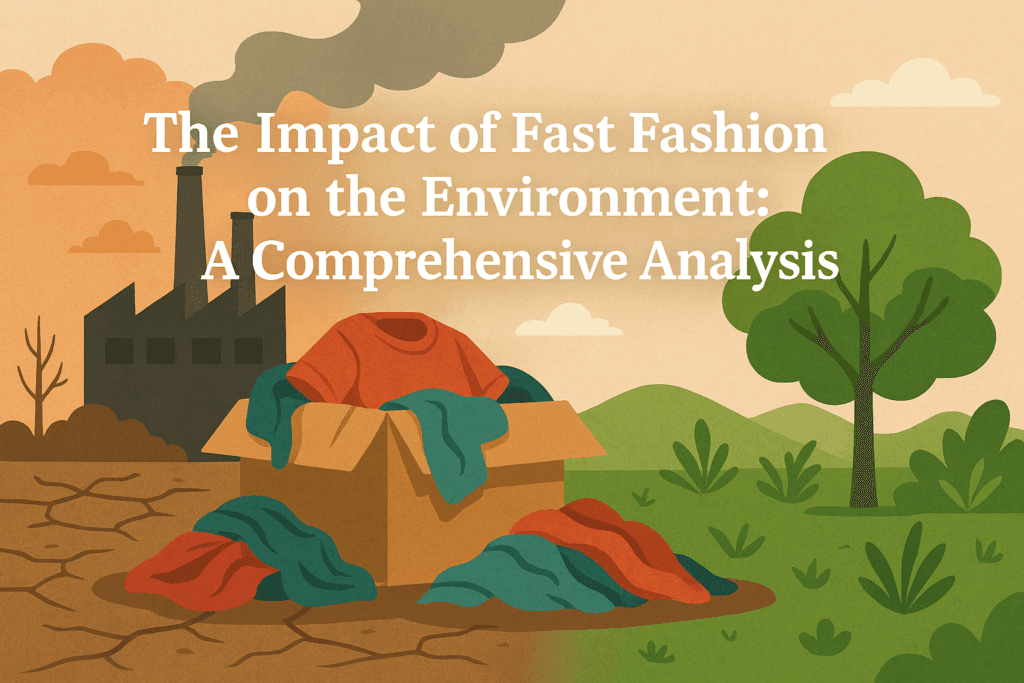
Fast fashion has revolutionized the way we buy and wear clothes, making trendy and affordable garments accessible to a broader audience.
However, this convenience comes at a significant cost to the environment.
This comprehensive guide will explore the environmental impacts of fast fashion, from resource consumption and pollution to waste generation and social consequences.
We’ll also discuss sustainable alternatives and actionable steps consumers can take to mitigate these impacts.
1. Understanding Fast Fashion

Fast fashion refers to the rapid production of inexpensive clothing to meet the latest fashion trends.
This business model emphasizes quick turnaround times, high volume production, and low costs, resulting in frequent new collections and short-lived garment lifespans.
Key Characteristics of Fast Fashion:
- Rapid Production: Quick turnaround from design to retail.
- High Volume: Large quantities of garments produced and sold.
- Low Prices: Affordable prices to attract mass consumption.
- Short Lifecycle: Trend-driven clothing with a short lifespan.
Popular Fast Fashion Brands:
- Zara
- H&M
- Forever 21
- Shein
Personal Anecdote:
Emma, a former fast fashion enthusiast, shares her experience: “I used to buy new clothes every few weeks to keep up with trends. Over time, I realized the negative impact it was having on my wallet and the environment. Now, I’m more mindful of my clothing choices and prioritize quality over quantity.”
2. Resource Consumption in Fast Fashion

The production of fast fashion garments involves the extensive use of natural resources, including water, energy, and raw materials. This resource-intensive process contributes significantly to environmental degradation.
Water Usage:
- Cotton Production: Cotton, a primary fabric in fast fashion, requires vast amounts of water. It takes approximately 2,700 liters of water to produce one cotton t-shirt.
- Dyeing and Finishing: The dyeing and finishing processes are water-intensive, often leading to water pollution.
Energy Consumption:
- Manufacturing: Fast fashion production involves energy-intensive processes, including spinning, weaving, dyeing, and finishing.
- Transportation: The global supply chain of fast fashion involves significant energy consumption for transportation.
Raw Materials:
- Cotton: Conventional cotton farming involves heavy pesticide and fertilizer use, contributing to soil degradation and water pollution.
- Synthetic Fibers: Polyester, a common synthetic fiber, is derived from petroleum, contributing to fossil fuel consumption and greenhouse gas emissions.
Statistics:
- The fashion industry is responsible for 10% of global carbon emissions.
- It takes about 10,000 liters of water to produce one kilogram of cotton, equivalent to a single pair of jeans.
Expert Opinion:
Dr. Mark Thompson, Environmental Scientist, states, “The resource consumption in fast fashion is unsustainable. From water usage to energy consumption, the environmental impact is profound and requires urgent attention.”
3. Pollution and Waste in Fast Fashion
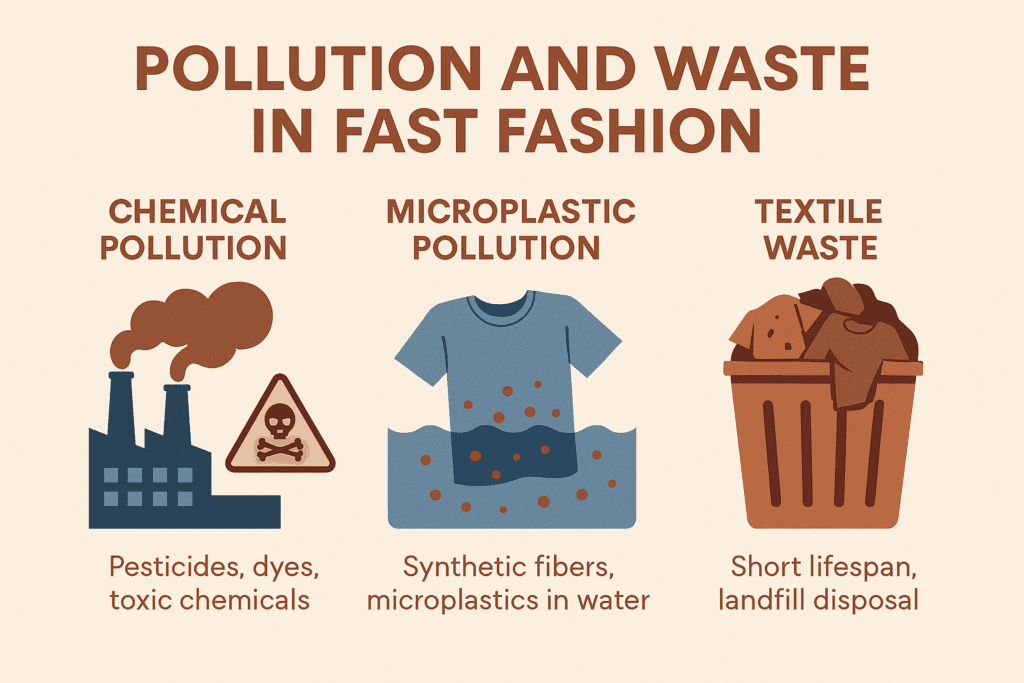
Fast fashion contributes significantly to environmental pollution and waste generation throughout its lifecycle, from production to disposal.
Chemical Pollution:
- Pesticides and Fertilizers: Conventional cotton farming uses large amounts of pesticides and fertilizers, leading to soil and water contamination.
- Dyeing and Finishing: The dyeing process releases toxic chemicals into water bodies, harming aquatic life and human health.
Microplastic Pollution:
- Synthetic Fibers: Washing synthetic garments releases microplastics into waterways, contributing to marine pollution.
- Environmental Impact: Microplastics are ingested by marine organisms, entering the food chain and affecting biodiversity.
Textile Waste:
- Short Lifespan: Fast fashion garments are designed for short-term use, leading to frequent disposal.
- Landfill Overflow: Millions of tons of textile waste end up in landfills each year, contributing to environmental degradation.
Statistics:
- The fashion industry produces 20% of global wastewater.
- An estimated 92 million tons of textile waste is generated annually.
Visual Example:
4. Social and Ethical Implications of Fast Fashion
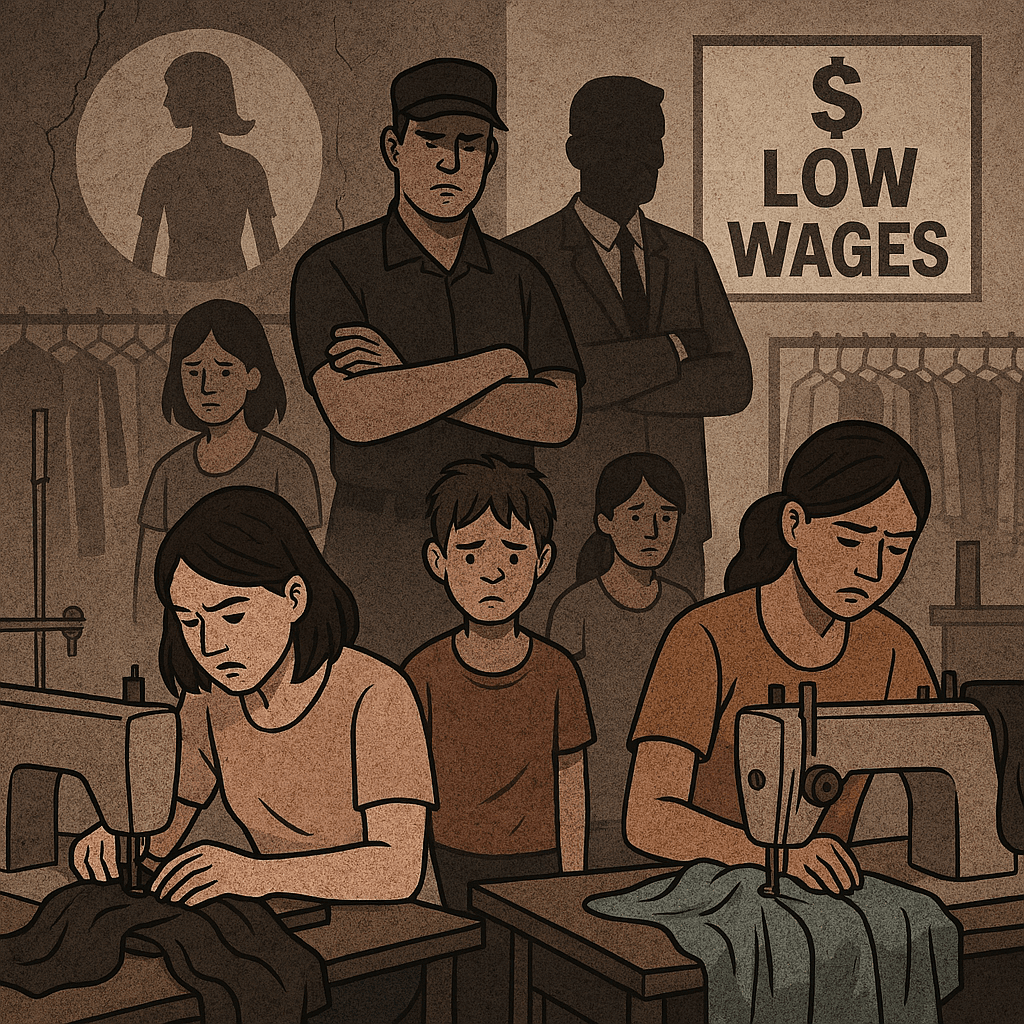
Fast fashion not only impacts the environment but also has significant social and ethical consequences.
The industry often relies on exploitative labor practices to maintain low costs and high production rates.
Labor Conditions:
- Low Wages: Many fast fashion workers are paid extremely low wages, often below the living wage.
- Poor Working Conditions: Workers frequently face unsafe working conditions, long hours, and lack of labor rights.
Child Labor:
- Exploitation: The fast fashion industry has been linked to child labor in various countries, exploiting vulnerable populations for cheap labor.
Gender Inequality:
- Women Workers: A significant proportion of garment workers are women, who often face gender discrimination and lack of opportunities for advancement.
Case Study:
The 2013 Rana Plaza Collapse in Bangladesh, which killed over 1,100 garment workers, highlighted the dire working conditions in the fast fashion industry. The tragedy brought global attention to the need for improved labor rights and safety standards.
Expert Opinion:
Dr. Susan Harper, Human Rights Advocate, explains, “The social and ethical implications of fast fashion are deeply concerning. Exploitative labor practices and poor working conditions are prevalent, and urgent reforms are needed to protect workers’ rights.”
5. Sustainable Alternatives to Fast Fashion
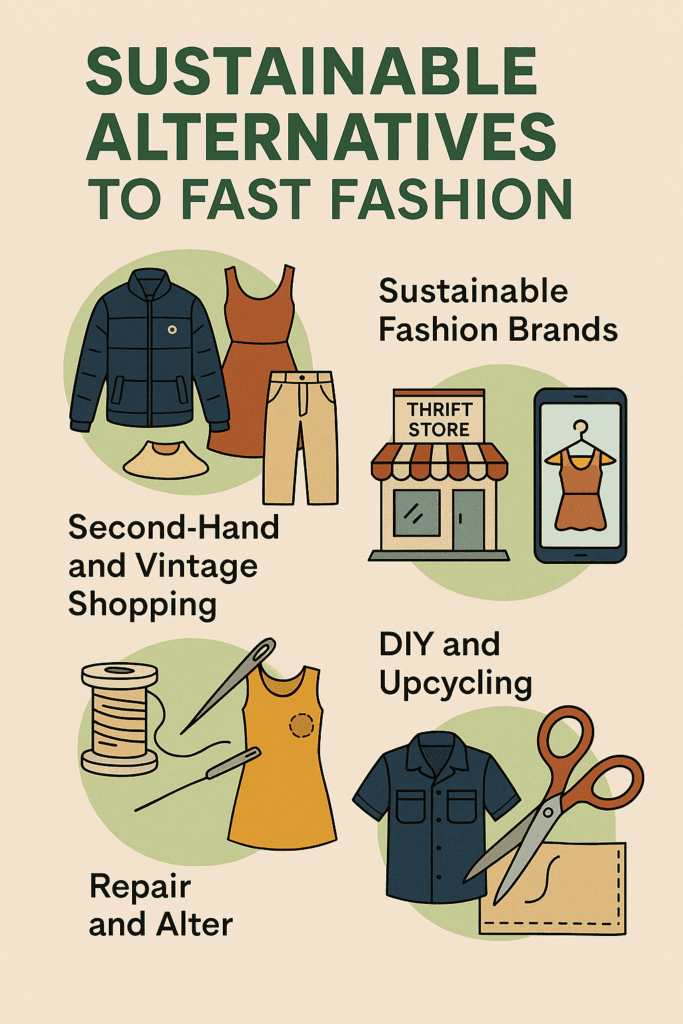
To mitigate the environmental and social impacts of fast fashion, consumers can explore sustainable alternatives.
These alternatives prioritize ethical production, eco-friendly materials, and longer-lasting garments.
Sustainable Fashion Brands:
- Patagonia:
- Focuses on environmental sustainability and fair labor practices.
- Uses recycled materials and organic cotton.
- Eileen Fisher:
- Emphasizes timeless designs and sustainable practices.
- Offers organic cotton, Tencel, and linen clothing.
- People Tree:
- Pioneer in Fair Trade and sustainable fashion.
- Features organic cotton, Tencel, and handmade textiles.
- Reformation:
- Known for trendy, eco-friendly fashion.
- Uses sustainable materials and transparent production processes.
Second-Hand and Vintage Shopping:
- Thrift Stores: Buying second-hand clothing reduces demand for new production and minimizes waste.
- Online Platforms: Websites like ThredUp, Poshmark, and Depop offer a wide range of second-hand and vintage clothing.
DIY and Upcycling:
- Repair and Alter: Extend the life of your clothes by repairing and altering them.
- Upcycle: Get creative and transform old garments into new, unique pieces.
Affiliate Links:
Visual Example:
6. Consumer Actions to Combat Fast Fashion
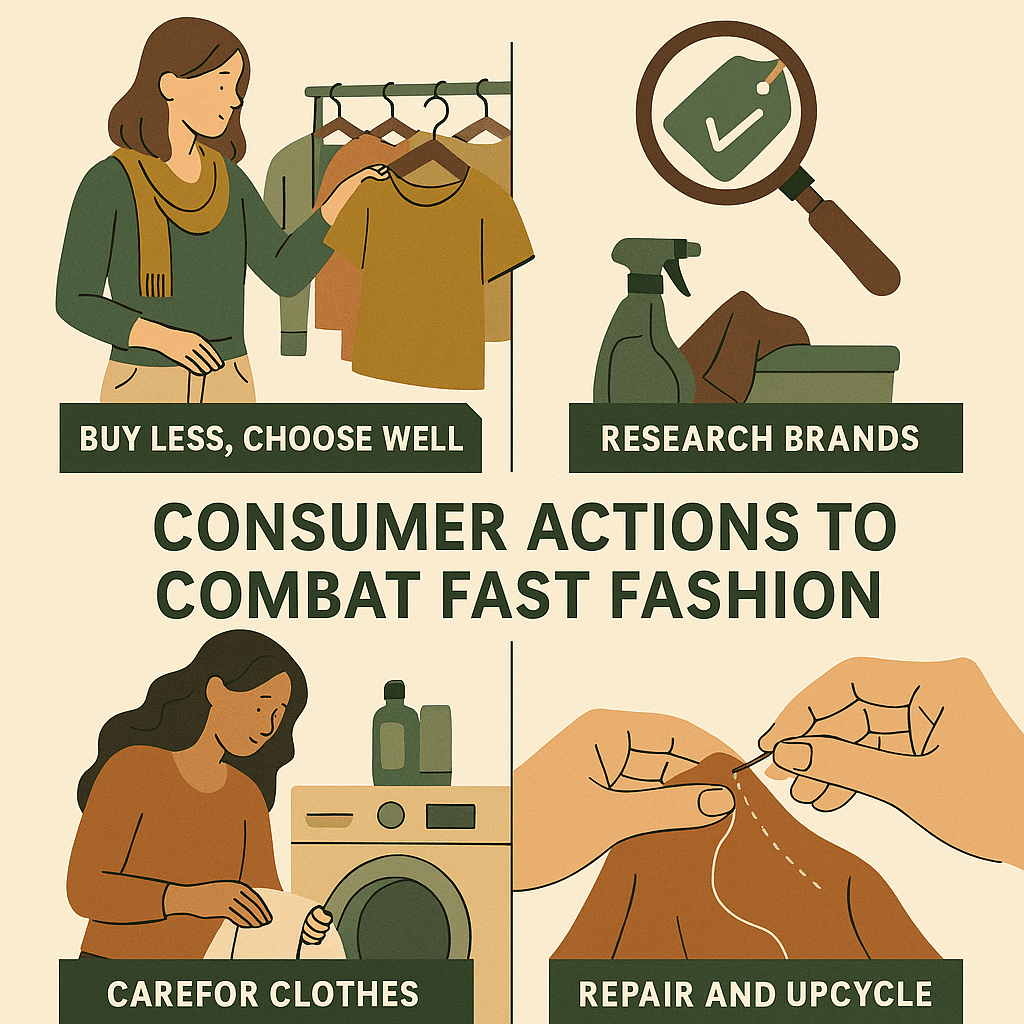
Consumers play a crucial role in combating the negative impacts of fast fashion.
By making mindful choices and supporting sustainable practices, individuals can drive positive change in the fashion industry.
Mindful Shopping:
- Buy Less, Choose Well:
- Focus on quality over quantity.
- Invest in timeless, versatile pieces that will last longer.
- Research Brands:
- Support brands that prioritize sustainability and ethical practices.
- Look for certifications like Fair Trade, GOTS, and OEKO-TEX.
- Avoid Impulse Buys:
- Think critically before making a purchase.
- Consider if the item fits your style, needs, and values.
Caring for Clothes:
- Wash Less Frequently:
- Washing clothes less frequently reduces water and energy usage.
- Spot clean minor stains and air out clothes to refresh them.
- Use Eco-Friendly Products:
- Choose biodegradable detergents and natural stain removers.
- Avoid fabric softeners and bleach.
- Repair and Upcycle:
- Repair damaged garments instead of discarding them.
- Get creative with upcycling projects to give old clothes a new life.
Advocacy and Awareness:
- Raise Awareness:
- Educate friends and family about the impacts of fast fashion.
- Share information on social media to spread awareness.
- Support Legislation:
- Advocate for policies that promote sustainability and labor rights in the fashion industry.
- Support organizations and campaigns working towards a more ethical fashion industry.
Affiliate Links:
Visual Example:
7. Industry Innovations and Initiatives

The fashion industry is evolving, with various innovations and initiatives aimed at reducing its environmental and social impacts.
Here are some notable efforts driving change in the industry.
Sustainable Materials:
- Lab-Grown Fabrics: Innovations in lab-grown fabrics, such as mushroom leather and bio-fabricated silk, offer sustainable alternatives to traditional materials.
- Recycled Fibers: The use of recycled polyester, nylon, and other fibers helps reduce waste and resource consumption.
Circular Fashion:
- Take-Back Programs: Brands like Patagonia and H&M offer take-back programs to recycle old garments.
- Rental Services: Clothing rental services, such as Rent the Runway, promote circular fashion by extending the life of garments.
Transparency and Traceability:
- Blockchain Technology: Blockchain technology is being used to improve transparency and traceability in the supply chain, ensuring ethical practices.
- Supply Chain Audits: Regular audits and certifications help ensure fair labor practices and environmental compliance.
Collaborative Initiatives:
- Sustainable Apparel Coalition: A global alliance of companies, NGOs, and government organizations working to reduce the environmental and social impacts of the apparel industry.
- Fashion for Good: An innovation platform that supports sustainable fashion startups and promotes circular economy practices.
Case Study:
Patagonia’s Worn Wear program encourages customers to trade in used gear for store credit, promoting a circular economy. The program has successfully extended the life of countless garments and reduced textile waste.
Expert Opinion:
Dr. Emily White, Sustainable Fashion Researcher, states, “Industry innovations and initiatives are crucial for driving systemic change in the fashion industry. Collaboration and technological advancements are key to achieving a more sustainable future.”
Visual Example:
8. The Future of Sustainable Fashion

The future of fashion lies in sustainability. As consumer awareness grows and technological advancements continue, the industry is poised for a significant transformation.
Here are some trends and predictions for the future of sustainable fashion.
Trends and Predictions:
- Increased Transparency:
- Greater demand for transparency in the supply chain will lead to improved ethical practices.
- Consumers will have access to more information about the origins and impacts of their clothing.
- Technological Innovations:
- Continued advancements in sustainable materials and production processes.
- Growth of digital platforms for second-hand shopping and clothing rentals.
- Circular Economy:
- Expansion of circular fashion models, including take-back programs, recycling, and upcycling.
- Brands will adopt circular design principles to minimize waste and extend garment life.
- Consumer Shift:
- Growing preference for quality, durability, and sustainability over fast fashion.
- Increased demand for ethically produced and eco-friendly clothing.
- Policy and Regulation:
- Governments and organizations will implement stricter regulations to promote sustainability and labor rights in the fashion industry.
- Introduction of policies to reduce carbon emissions and waste in the fashion sector.
Impact on the Industry:
- Sustainable Growth: The fashion industry will experience sustainable growth driven by consumer demand and innovation.
- Positive Change: Increased collaboration and transparency will lead to positive environmental and social impacts.
- Empowered Consumers: Consumers will play a crucial role in shaping the future of fashion through informed choices and advocacy.
Expert Opinion:
Dr. Laura Green, Environmental Scientist, explains, “The future of fashion is rooted in sustainability. As technology advances and consumer demand grows, we can expect significant strides towards a more ethical and eco-friendly industry.”
Visual Example:
9. Educational Resources and Further Reading

Educating yourself about sustainable fashion is a crucial step in making informed choices and driving positive change.
Here are some recommended resources for further reading and learning.
Books:
- “Fashionopolis: The Price of Fast Fashion and the Future of Clothes” by Dana Thomas
- Explores the impact of fast fashion and the innovators working towards a more sustainable future.
- “Overdressed: The Shockingly High Cost of Cheap Fashion” by Elizabeth L. Cline
- Investigates the consequences of fast fashion and offers insights into sustainable alternatives.
- “The Conscious Closet: The Revolutionary Guide to Looking Good While Doing Good” by Elizabeth L. Cline
- Provides practical advice for building a sustainable wardrobe and caring for your clothes.
Documentaries:
- “The True Cost” (2015)
- A documentary that explores the impact of fast fashion on people and the planet.
- “RiverBlue” (2017)
- Investigates the environmental impact of the fashion industry’s water pollution.
- “Minimalism: A Documentary About the Important Things” (2016)
- Explores the benefits of minimalism and mindful consumption.
Websites and Blogs:
- Fashion Revolution:
- A global movement advocating for transparency and sustainability in the fashion industry.
- EcoCult:
- A blog focused on sustainable living and ethical fashion.
- The Good Trade:
- Offers resources and guides on sustainable fashion, beauty, and lifestyle.
Online Courses:
- Sustainable Fashion by FutureLearn:
- An online course exploring the principles of sustainable fashion and ethical practices.
- Fashion as Design by Coursera:
- A course that examines the choices made by designers and consumers in the fashion industry.
Affiliate Links:
Visual Example:
10. Conclusion: Taking Action Against Fast Fashion

The impact of fast fashion on the environment is profound and far-reaching.
By understanding these impacts and making informed choices, consumers can play a vital role in driving positive change in the fashion industry.
Action Steps:
- Educate Yourself:
- Stay informed about the environmental and social impacts of fast fashion.
- Share your knowledge with others to raise awareness.
- Support Sustainable Brands:
- Choose brands that prioritize sustainability and ethical practices.
- Look for certifications like Fair Trade, GOTS, and OEKO-TEX.
- Practice Mindful Consumption:
- Buy less and choose well.
- Invest in quality, durable pieces that will last longer.
- Care for Your Clothes:
- Adopt sustainable clothing care practices to extend garment life.
- Repair and upcycle damaged items instead of discarding them.
- Advocate for Change:
- Support policies and initiatives that promote sustainability and labor rights in the fashion industry.
- Participate in campaigns and movements advocating for a more ethical fashion industry.
Thank you for joining us on this comprehensive guide to the impact of fast fashion on the environment. By taking action and making mindful choices, we can contribute to a more sustainable and ethical future for the fashion industry.


